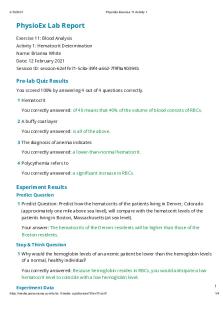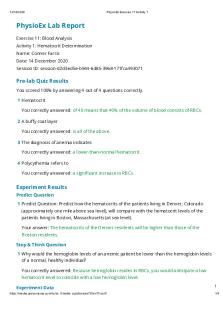Physio Ex Exercise 11 Activity 4 PDF

| Title | Physio Ex Exercise 11 Activity 4 |
|---|---|
| Author | Emily Connors |
| Course | Anatomy & Physiology II |
| Institution | Memorial University of Newfoundland |
| Pages | 4 |
| File Size | 236.4 KB |
| File Type | |
| Total Downloads | 78 |
| Total Views | 154 |
Summary
Download Physio Ex Exercise 11 Activity 4 PDF
Description
5/17/2020
PhysioEx Exercise 11 Activity 4
PhysioEx Lab Report Exercise 11: Blood Analysis Activity 4: Blood Typing Name: Emily Connors Date: 17 May 2020 Session ID: session-6b7e30f9-fa4b-e613-9c88-1ae5c347ecb7
Pre-lab Quiz Results You scored 100% by answering 4 out of 4 questions correctly. 1 Red blood cell membranes have You correctly answered: agglutinogens that specify that individual's blood type. 2 ABO and Rh antigens You correctly answered: All of these answers are correct. 3 Which of the following statements about blood types is correct? You correctly answered: A person with type O blood has two recessive alleles and has neither the type A nor type B antigen. 4 Antibodies to the A and B antigens are You correctly answered: found preformed in the blood plasma.
Experiment Results Predict Question 1 Predict Question: If the patient's blood type is AB -, what would be the appearance of the A, B, and Rh samples? Your answer: A, clumped; B, unclumped; Rh, clumped. Stop & Think Question 1 Why are individuals with the AB + blood type known as universal recipients for blood transfusions? You correctly answered: They have both A and B antigens on the surface of their RBCs, and their blood serum does not contain antibodies against A, B, or Rh antigens. Experiment Data Blood sample
Agglutination with Anti-A Serum
Agglutination with Anti-B Serum
https://media.pearsoncmg.com/bc/bc_0media_ap/physioex/10/ex11/act4/
Agglutination with Anti-Rh Serum
Blood Type
Rh factor
1/4
5/17/2020
PhysioEx Exercise 11 Activity 4
1
positive
negative
positive
A
+
2
negative
positive
positive
B
+
3
positive
positive
negative
AB
-
4
negative
negative
negative
O
-
5
positive
positive
positive
AB
+
6
negative
positive
negative
B
-
Sample 6 https://media.pearsoncmg.com/bc/bc_0media_ap/physioex/10/ex11/act4/
2/4
5/17/2020
PhysioEx Exercise 11 Activity 4
Post-lab Quiz Results You scored 100% by answering 4 out of 4 questions correctly. 1 To determine an individual's blood type, drops of the blood sample are mixed You correctly answered: separately with antiserum containing antibodies that recognize either type A antigens, type B antigens, or Rh antigens. 2 Agglutination You correctly answered: All of these answers are correct. 3 Antigens You correctly answered: are present on all cells. 4 ABO and Rh agglutinogens You correctly answered: cause the most vigorous and potentially fatal transfusion reactions.
Review Sheet Results 1 How did the appearance of the A, B, and Rh samples for the patient with AB - blood type compare with your prediction? Your answer: My prediction did not match the results because A was clumped, B was clumped, and Rh was not clumped, it was smooth. 2 Which blood sample contained the rarest blood type? Your answer: AB- contained the rarest blood type. 3 Which blood sample contained the universal donor? Your answer: O- contained the universal donor. https://media.pearsoncmg.com/bc/bc_0media_ap/physioex/10/ex11/act4/
3/4
5/17/2020
PhysioEx Exercise 11 Activity 4
4 Which blood sample contained the universal recipient? Your answer: AB+ contained the universal recipient. 5 Which blood sample did not agglutinate with any of the antibodies tested? Why? Your answer: Sample 4 didn't agglutinate with any of the antibodies tested because none of the antigens were present. 6 What antibodies would be found in the plasma of blood sample 1? Your answer: Anti-B antibody was found in sample 1. 7 When transfusing an individual with blood that is compatible but not the same type, it is important to separate packed cells from the plasma and administer only the packed cells. Why do you think this is done? (Hint: think about what is in plasma versus what is on
RBCs.) Your answer: This is done because the plasma contains antibodies that can react with the recipients antigens on red blood cells. 8 List the blood samples in this activity that represent people who could donate blood to a person with type B+ blood. Your answer: B+ (sample 2), B- (sample 6), O- (sample 4).
https://media.pearsoncmg.com/bc/bc_0media_ap/physioex/10/ex11/act4/
4/4...
Similar Free PDFs

Physio Ex Exercise 11 Activity 4
- 4 Pages

Physio Ex Exercise 11 Activity 4
- 4 Pages

Physio Ex Exercise 11 Activity 4
- 6 Pages

Physio Ex Exercise 4 Activity 4
- 3 Pages

Physio Ex Exercise 4 Activity 4
- 3 Pages

Physio Ex Exercise 11 Activity 1
- 4 Pages

Physio Ex Exercise 11 Activity 1
- 4 Pages

Physio Ex Exercise 11 Activity 1
- 4 Pages

Physio Ex Exercise 11 Activity 2
- 5 Pages

Physio Ex Exercise 11 Activity 3
- 3 Pages

Physio Ex Exercise 4 Activity 4
- 3 Pages

Physio Ex Exercise 11 Activity 2
- 3 Pages

Physio Ex Exercise 11 Activity 1
- 4 Pages

Physio Ex Exercise 11 Activity 5
- 3 Pages

Physio Ex Exercise 11 Activity 2
- 3 Pages

Physio Ex Exercise 11 Activity 3
- 3 Pages
Popular Institutions
- Tinajero National High School - Annex
- Politeknik Caltex Riau
- Yokohama City University
- SGT University
- University of Al-Qadisiyah
- Divine Word College of Vigan
- Techniek College Rotterdam
- Universidade de Santiago
- Universiti Teknologi MARA Cawangan Johor Kampus Pasir Gudang
- Poltekkes Kemenkes Yogyakarta
- Baguio City National High School
- Colegio san marcos
- preparatoria uno
- Centro de Bachillerato Tecnológico Industrial y de Servicios No. 107
- Dalian Maritime University
- Quang Trung Secondary School
- Colegio Tecnológico en Informática
- Corporación Regional de Educación Superior
- Grupo CEDVA
- Dar Al Uloom University
- Centro de Estudios Preuniversitarios de la Universidad Nacional de Ingeniería
- 上智大学
- Aakash International School, Nuna Majara
- San Felipe Neri Catholic School
- Kang Chiao International School - New Taipei City
- Misamis Occidental National High School
- Institución Educativa Escuela Normal Juan Ladrilleros
- Kolehiyo ng Pantukan
- Batanes State College
- Instituto Continental
- Sekolah Menengah Kejuruan Kesehatan Kaltara (Tarakan)
- Colegio de La Inmaculada Concepcion - Cebu